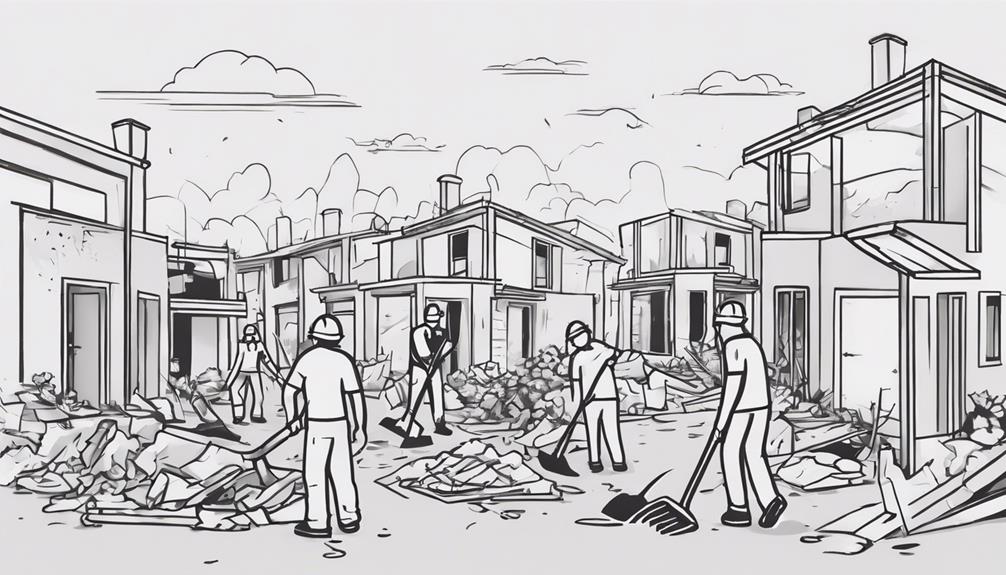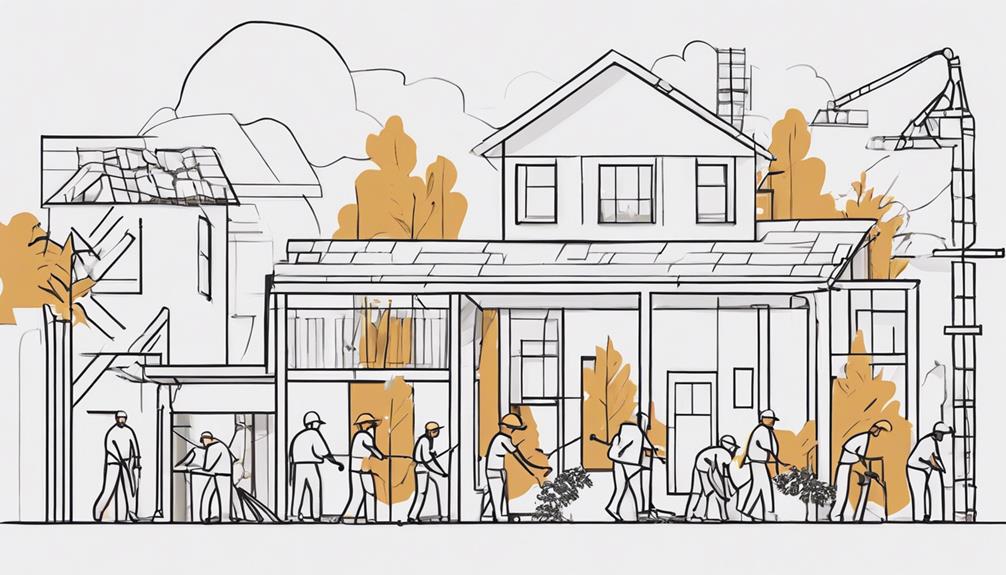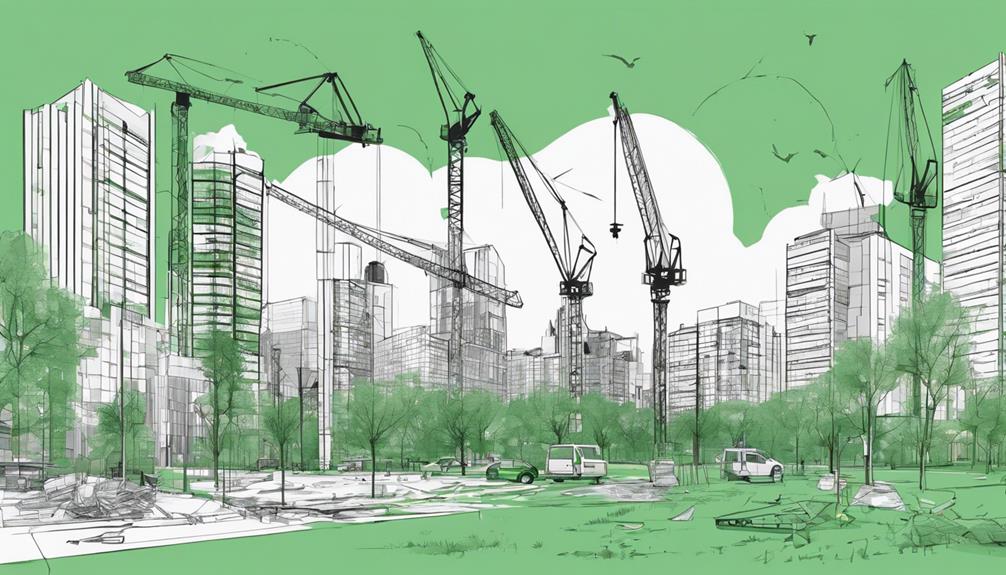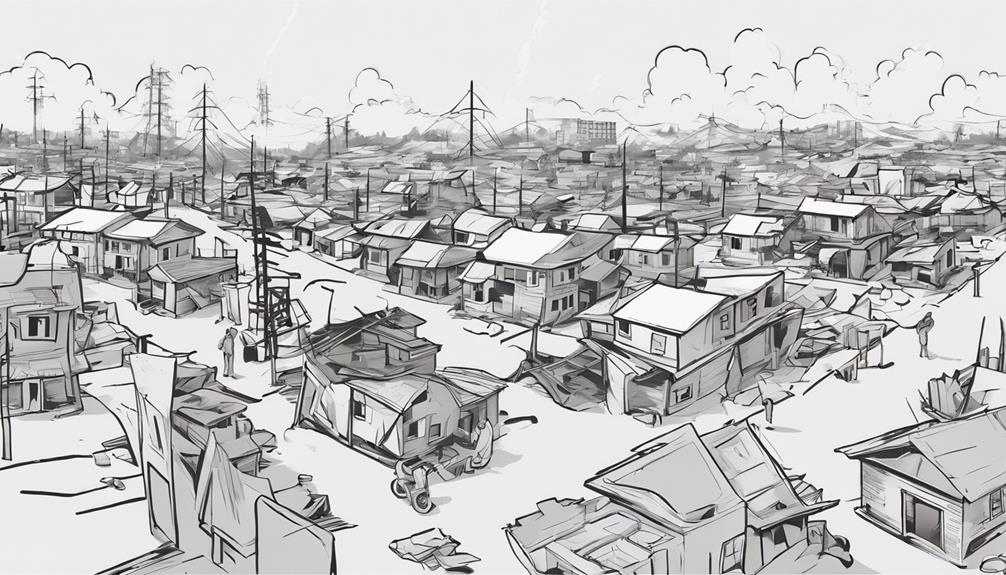In the aftermath of a disaster, the intricate process of community rebuilding and recovery unfolds through a strategic interplay of resilience-building initiatives and post-crisis restoration efforts. Delving into the multifaceted aspects of recovery planning, from infrastructure rehabilitation to social cohesion enhancement, a critical examination of the mechanisms at play reveals the intricate web of factors influencing successful recovery outcomes. As communities navigate the complexities of post-disaster recovery, the question arises: how do these diverse elements coalesce to foster sustainable and resilient communities in the face of adversity?
Key Takeaways
- Community resilience progresses through phases like heroic, honeymoon, disillusionment, and reconstruction.
- Identifying and prioritizing post-disaster needs ensures efficient resource allocation for recovery efforts.
- Resource allocation for recovery focuses on critical needs like shelter, food, and infrastructure repair.
- Government support, social cohesion, and community engagement are vital in rebuilding and recovery post-disaster.
Community Resilience and Recovery Phases

Community resilience and recovery phases play a crucial role in understanding and navigating the post-disaster trajectory of communities. The concept of disaster resilience refers to the ability of a community to withstand, adapt to, and recover from natural disasters. Community recovery, on the other hand, involves a series of phases that communities go through following a disaster. These phases include the heroic phase, honeymoon phase, disillusionment phase, and reconstruction phase.
The heroic phase is characterized by intense rescue efforts and strong community support immediately after the disaster. During the honeymoon phase, there is a sense of high community cohesion and optimism regarding recovery efforts. However, the disillusionment phase reveals the resource limits and challenges faced by communities during the rebuilding process. Finally, the reconstruction phase marks progress in rebuilding efforts and the adjustment to the new normal post-disaster.
Understanding these phases is essential for effective disaster management and fostering community resilience. By recognizing the different stages of community recovery, stakeholders can better address the evolving needs of the affected population and facilitate a smoother transition towards a more resilient future.
Identifying Post-Disaster Needs
Post-disaster needs assessments play a crucial role in determining the scope of damages and required resources for effective recovery. Immediate assessments focus on securing essentials like shelter, food, water, and medical care to address urgent needs post-disaster. Collaborative efforts with various stakeholders are essential to identify vulnerable populations, prioritize recovery efforts, and allocate resources efficiently.
Basic Needs Assessment
Following a disaster, conducting a thorough basic needs assessment is imperative to accurately identify and prioritize essential requirements for effective post-disaster recovery efforts. This assessment plays a crucial role in understanding the immediate needs of the affected community. Key aspects of basic needs assessments include:
- Identifying essential requirements such as shelter, food, water, and medical care.
- Prioritizing resources and aid distribution based on the community's urgent needs.
- Guiding the allocation of resources and services for a structured recovery process.
- Evaluating infrastructure damage, health risks, and population vulnerabilities to tailor recovery efforts.
Resource Allocation
Effective post-disaster recovery hinges on the meticulous identification and prioritization of critical needs through strategic resource allocation. Resource allocation post-disaster involves assessing damages, risks, population size, infrastructure damage, and community vulnerabilities to make informed decisions. Recovery funds and resources are allocated to address urgent needs such as shelter, food, and medical assistance. Cooperation with local, state, and federal agencies is essential for efficient resource allocation in rebuilding and recovery endeavors. Community engagement and needs assessments are vital in determining priorities for long-term recovery planning, ensuring that resources are directed where they are most needed. By carefully allocating resources based on these considerations, communities can effectively reduce the impact of disasters and expedite the recovery process.
Implementing Recovery Plans Effectively

Effective implementation of recovery plans hinges upon meticulous plan execution strategies that align with overarching goals, continuous monitoring of progress to identify areas needing adjustment, and the flexibility to adapt to evolving circumstances. These key points underscore the importance of a well-structured approach that ensures the seamless transition from response to recovery, emphasizing the critical role of strategic coordination and communication in successful plan execution. By adhering to these principles, communities can navigate the complexities of post-disaster recovery with resilience and efficiency.
Plan Execution Strategies
To ensure the successful implementation of recovery plans post-disaster, meticulous coordination and adherence to established strategies are paramount.
- Established Goals: Clearly defined objectives guide the recovery process and aid in measuring progress effectively.
- Business Continuity: Ensuring businesses have plans in place to continue operations helps maintain stability in communities impacted.
- De-escalation of Response: Shifting focus from immediate response to long-term recovery is essential for restoring normal functions.
- Effective Communication: Keeping all stakeholders informed and involved throughout the recovery process fosters cooperation and understanding.
Monitoring Progress Continuously
Continuous monitoring of progress is a critical component in ensuring the effective implementation of recovery plans following a disaster. By tracking key performance indicators, stakeholders can assess the success of post-disaster recovery efforts and make necessary adjustments to the plan. Regular monitoring not only helps in identifying challenges and barriers but also keeps stakeholders informed and engaged throughout the process. Evaluating progress is essential in determining the effectiveness of recovery strategies, informing future disaster preparedness, and ensuring public health considerations are addressed.
| Benefits of Continuous Monitoring | |
|---|---|
| Ensures recovery plans are on track | Identifies challenges |
| Tracks key performance indicators | Keeps stakeholders engaged |
| Evaluates effectiveness of strategies | Addresses public health considerations |
Flexibility in Adaptation
In the aftermath of a disaster, the ability for communities to adjust their recovery plans based on evolving needs and challenges becomes paramount, highlighting the critical necessity of flexibility in adaptation for effective implementation.
- Flexibility in adaptation allows communities to modify strategies and actions to address emerging issues.
- Adapting recovery plans in real-time ensures prioritization of critical needs post-disaster.
- Remaining agile in recovery efforts helps communities navigate uncertainties and complexities.
- Flexibility is essential for optimizing resources, engaging stakeholders, and achieving sustainable long-term recovery goals.
Rebuilding Infrastructure and Resilience

Efforts to rebuild infrastructure and enhance resilience following a disaster play a critical role in restoring essential services and safeguarding communities against future calamities. Post-disaster infrastructure rebuilding involves repairing vital components like roads, bridges, and utilities to reinstate necessary services promptly. This restoration is crucial for the community's daily functioning and economic recovery. To enhance infrastructure resilience, it is imperative to incorporate disaster-resistant materials and designs, reducing vulnerability to potential future disasters. Collaborative efforts involving entities such as the Emergency Management Agency (FEMA) and the Department of Health are essential in overseeing these rebuilding initiatives. By strengthening infrastructure and making it more resilient, communities can better withstand and recover from the impact of disasters. This proactive approach not only ensures a faster recovery but also minimizes the long-term effects of such events, fostering a more robust and secure environment for residents.
Leveraging Community Resources for Recovery
Following the imperative task of rebuilding infrastructure and enhancing resilience post-disaster, a strategic shift towards leveraging community resources for recovery emerges as a pivotal step in fostering comprehensive and sustainable reconstruction efforts. Collaboration with local businesses, schools, and organizations plays a crucial role in supporting recovery initiatives and ensuring inclusivity. Engaging a Whole Community approach is essential to involve all sectors of society in the rebuilding process, maximizing the effectiveness of recovery efforts. By tapping into these community resources, immediate needs can be addressed, economic recovery facilitated, and the overall resilience of the community enhanced. Furthermore, leveraging local expertise and resources enables communities to accelerate their recovery efforts, ultimately leading to a stronger and more resilient community post-disaster. This collaborative approach not only aids in the recovery process but also fosters a sense of unity and shared responsibility within the community.
Role of Government Support in Rebuilding

Government support in the process of rebuilding post-disaster involves the allocation of funds for critical infrastructure repairs and community redevelopment initiatives. Federal agencies such as the Federal Emergency Management Agency (FEMA) play a crucial role in providing grants and assistance programs to aid communities in their recovery efforts. State and local governments also contribute significantly by coordinating resources and offering regulatory support to streamline rebuilding processes. Collaboration between government agencies and community stakeholders is essential in developing long-term recovery plans that address various needs such as housing, economic revitalization, and environmental restoration.
Moreover, public-private partnerships are instrumental in leveraging government resources effectively, ensuring a more efficient rebuilding process in disaster-affected areas. These partnerships enable the pooling of expertise and resources from both sectors to expedite recovery efforts and enhance the overall resilience of communities. By working together cohesively, government entities and various stakeholders can pave the way for a more sustainable and comprehensive recovery following a disaster.
Strengthening Social Cohesion in Recovery
Enhancing social cohesion in the aftermath of a disaster is paramount for fostering community resilience and facilitating effective recovery. Strengthening social networks post-disaster involves fostering trust, cooperation, and resilience among community members. To achieve this, community engagement plays a crucial role through activities such as town hall meetings, support groups, and volunteer initiatives, which promote unity and solidarity. Additionally, addressing social disparities and promoting inclusivity can further strengthen social cohesion, facilitating a more equitable recovery process. Building relationships with local organizations, faith-based groups, and cultural institutions is also essential as it can enhance community resilience and well-being post-disaster. Overall, prioritizing social cohesion and fostering community engagement are vital components in the recovery process, as they enable effective communication, mutual support, and resource sharing among community members, ultimately contributing to a more cohesive and resilient community in the face of adversity.
Addressing Mental Health and Wellbeing

Addressing mental health and wellbeing post-disaster is a critical component of promoting overall community resilience and recovery. The aftermath of a disaster often brings about various mental health challenges such as stress, anxiety, depression, and post-traumatic stress disorder (PTSD). To effectively support individuals dealing with trauma, it is essential to provide emotional support and counseling services. In the process of community healing, it is crucial to address emotional reactions and ensure access to mental health resources.
Organizations like the Nebraska Rural Response Hotline offer valuable assistance by providing free support and referrals for mental health counseling. Seeking help from licensed behavioral health professionals can significantly aid individuals in coping with distress and feelings of hopelessness. By prioritizing mental health support and emotional well-being post-disaster, communities can facilitate the recovery process and enhance overall resilience. It is imperative to recognize the importance of mental health care in rebuilding communities and fostering long-term recovery.
Sustainable Practices for Long-Term Recovery
The integration of sustainable practices in post-disaster recovery efforts is paramount for ensuring long-term resilience and environmental stewardship within communities. Sustainable practices for long-term recovery focus on minimizing environmental impact and promoting community resilience. Key aspects include incorporating green infrastructure, renewable energy, and sustainable building materials. These practices not only aid in recovery but also ensure a more resilient and environmentally conscious future for the community. Long-term recovery efforts aim to reduce future disaster risks and enhance the overall sustainability of the community. Community engagement and participation in sustainable practices play a crucial role in the success of long-term recovery initiatives. By working together and implementing sustainable strategies, communities can rebuild in a way that not only restores what was lost but also strengthens them against future natural disasters. The Department of Agriculture plays a significant role in promoting sustainable practices for long-term recovery and environmental sustainability.
Frequently Asked Questions
How Do People Recover From Natural Disasters?
Recovering from natural disasters involves prioritizing mental health and rebuilding infrastructure. Individuals focus on family well-being, seek medical aid promptly, and adhere to local authorities' guidance. Post-disaster challenges, both physical and psychological, are monitored for a successful recovery. Ensuring safety from hazards like gas leaks is critical. Documenting damages accurately before cleanup is vital for insurance purposes. The process of recovery emphasizes health, safety, and practical measures to restore stability.
How Do Communities Come Together After a Natural Disaster?
Communities exhibit resilience by uniting through community support mechanisms to initiate rebuilding efforts after a natural disaster. Local organizations, faith-based groups, and mutual aid networks play integral roles in providing immediate relief and resources. Fundraising events and donation drives also contribute to raising awareness and funds for post-disaster recovery. Effective communication through town halls and community meetings fosters coordination for a cohesive rebuilding strategy.
What Is the Ability of a Community to Recover After a Disaster?
The ability of a community to recover after a disaster is contingent upon its level of community resilience and disaster preparedness. Community resilience, characterized by the capacity to anticipate, respond to, and adapt to stressors, is essential for effective recovery post-disaster. Disaster preparedness, encompassing pre-disaster planning, resource allocation, and collaboration with stakeholders, further enhances a community's ability to bounce back from adversities. Emphasizing these factors can significantly bolster a community's recovery efforts.
Can Communities Fully Recover From Natural Disasters?
Communities can strive towards full recovery from natural disasters, yet the process is complex and may span years. Factors such as long-term impacts and psychological resilience play vital roles in this journey. Through coordinated efforts addressing physical, social, economic, and environmental dimensions, communities can gradually rebuild and fortify their resilience. Successful recovery hinges on community engagement, government support, and strategic partnerships, underscoring the significance of a multifaceted approach in achieving full recovery post-disaster.
Conclusion
In conclusion, the process of rebuilding and recovering after a disaster involves various phases and core capabilities that focus on short-term restoration and long-term resilience. By collaborating with partners, assessing needs, implementing recovery plans effectively, and leveraging community resources, communities can work towards rebuilding their infrastructure and enhancing disaster resilience. For example, the city of New Orleans successfully rebuilt after Hurricane Katrina by implementing sustainable practices and utilizing government support to strengthen social cohesion and address mental health needs.
